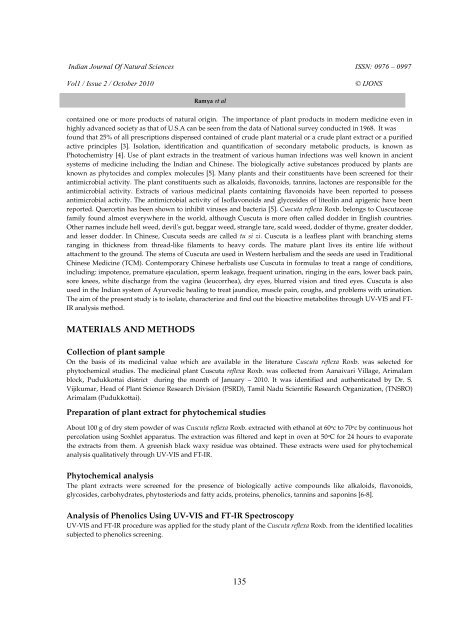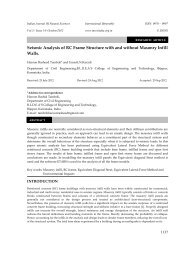Agroecology for Sustainable Food Security - tnsroindia.org.in
Agroecology for Sustainable Food Security - tnsroindia.org.in
Agroecology for Sustainable Food Security - tnsroindia.org.in
Create successful ePaper yourself
Turn your PDF publications into a flip-book with our unique Google optimized e-Paper software.
Indian Journal Of Natural Sciences ISSN: 0976 – 0997<br />
Vol1 / Issue 2 / October 2010 © IJONS<br />
conta<strong>in</strong>ed one or more products of natural orig<strong>in</strong>. The importance of plant products <strong>in</strong> modern medic<strong>in</strong>e even <strong>in</strong><br />
highly advanced society as that of U.S.A can be seen from the data of National survey conducted <strong>in</strong> 1968. It was<br />
found that 25% of all prescriptions dispensed conta<strong>in</strong>ed of crude plant material or a crude plant extract or a purified<br />
active pr<strong>in</strong>ciples [3]. Isolation, identification and quantification of secondary metabolic products, is known as<br />
Photochemistry [4]. Use of plant extracts <strong>in</strong> the treatment of various human <strong>in</strong>fections was well known <strong>in</strong> ancient<br />
systems of medic<strong>in</strong>e <strong>in</strong>clud<strong>in</strong>g the Indian and Ch<strong>in</strong>ese. The biologically active substances produced by plants are<br />
known as phytocides and complex molecules [5]. Many plants and their constituents have been screened <strong>for</strong> their<br />
antimicrobial activity. The plant constituents such as alkaloids, flavonoids, tann<strong>in</strong>s, lactones are responsible <strong>for</strong> the<br />
antimicrobial activity. Extracts of various medic<strong>in</strong>al plants conta<strong>in</strong><strong>in</strong>g flavonoids have been reported to possess<br />
antimicrobial activity. The antimicrobial activity of Isoflavonoids and glycosides of liteol<strong>in</strong> and apigenic have been<br />
reported. Quercet<strong>in</strong> has been shown to <strong>in</strong>hibit viruses and bacteria [5]. Cuscuta reflexa Roxb. belongs to Cuscutaceae<br />
family found almost everywhere <strong>in</strong> the world, although Cuscuta is more often called dodder <strong>in</strong> English countries.<br />
Other names <strong>in</strong>clude hell weed, devil's gut, beggar weed, strangle tare, scald weed, dodder of thyme, greater dodder,<br />
and lesser dodder. In Ch<strong>in</strong>ese, Cuscuta seeds are called tu si zi. Cuscuta is a leafless plant with branch<strong>in</strong>g stems<br />
rang<strong>in</strong>g <strong>in</strong> thickness from thread-like filaments to heavy cords. The mature plant lives its entire life without<br />
attachment to the ground. The stems of Cuscuta are used <strong>in</strong> Western herbalism and the seeds are used <strong>in</strong> Traditional<br />
Ch<strong>in</strong>ese Medic<strong>in</strong>e (TCM). Contemporary Ch<strong>in</strong>ese herbalists use Cuscuta <strong>in</strong> <strong>for</strong>mulas to treat a range of conditions,<br />
<strong>in</strong>clud<strong>in</strong>g: impotence, premature ejaculation, sperm leakage, frequent ur<strong>in</strong>ation, r<strong>in</strong>g<strong>in</strong>g <strong>in</strong> the ears, lower back pa<strong>in</strong>,<br />
sore knees, white discharge from the vag<strong>in</strong>a (leucorrhea), dry eyes, blurred vision and tired eyes. Cuscuta is also<br />
used <strong>in</strong> the Indian system of Ayurvedic heal<strong>in</strong>g to treat jaundice, muscle pa<strong>in</strong>, coughs, and problems with ur<strong>in</strong>ation.<br />
The aim of the present study is to isolate, characterize and f<strong>in</strong>d out the bioactive metabolites through UV-VIS and FT-<br />
IR analysis method.<br />
MATERIALS AND METHODS<br />
Ramya et al<br />
Collection of plant sample<br />
On the basis of its medic<strong>in</strong>al value which are available <strong>in</strong> the literature Cuscuta reflexa Roxb. was selected <strong>for</strong><br />
phytochemical studies. The medic<strong>in</strong>al plant Cuscuta reflexa Roxb. was collected from Aanaivari Village, Arimalam<br />
block, Pudukkottai district dur<strong>in</strong>g the month of January – 2010. It was identified and authenticated by Dr. S.<br />
Vijikumar, Head of Plant Science Research Division (PSRD), Tamil Nadu Scientific Research Organization, (TNSRO)<br />
Arimalam (Pudukkottai).<br />
Preparation of plant extract <strong>for</strong> phytochemical studies<br />
About 100 g of dry stem powder of was Cuscuta reflexa Roxb. extracted with ethanol at 60 o c to 70 o c by cont<strong>in</strong>uous hot<br />
percolation us<strong>in</strong>g Soxhlet apparatus. The extraction was filtered and kept <strong>in</strong> oven at 50 o C <strong>for</strong> 24 hours to evaporate<br />
the extracts from them. A greenish black waxy residue was obta<strong>in</strong>ed. These extracts were used <strong>for</strong> phytochemical<br />
analysis qualitatively through UV-VIS and FT-IR.<br />
Phytochemical analysis<br />
The plant extracts were screened <strong>for</strong> the presence of biologically active compounds like alkaloids, flavonoids,<br />
glycosides, carbohydrates, phytosteriods and fatty acids, prote<strong>in</strong>s, phenolics, tann<strong>in</strong>s and sapon<strong>in</strong>s [6-8].<br />
Analysis of Phenolics Us<strong>in</strong>g UV-VIS and FT-IR Spectroscopy<br />
UV-VIS and FT-IR procedure was applied <strong>for</strong> the study plant of the Cuscuta reflexa Roxb. from the identified localities<br />
subjected to phenolics screen<strong>in</strong>g.<br />
135



